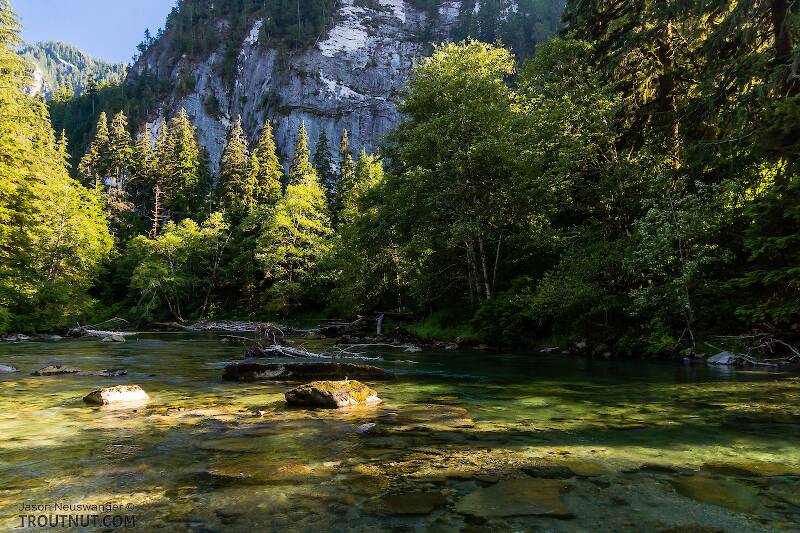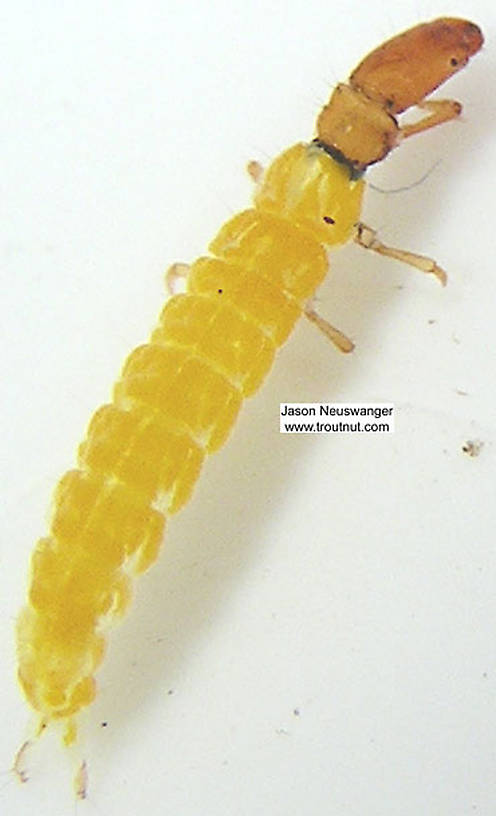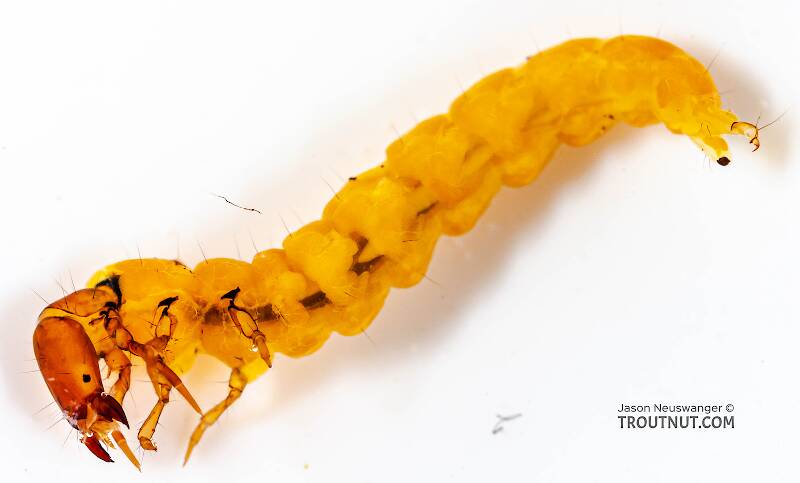
Hex Mayflies
Hexagenia limbata
The famous nocturnal Hex hatch of the Midwest (and a few other lucky locations) stirs to the surface mythically large brown trout that only touch streamers for the rest of the year.
Featured on the forum

I caught this tiny larva without a case, but it seems to key pretty clearly to to Glossosomatidae. From there, the lack of sclerites on the mesonotum points to either Glossosoma or Anagapetus. Although it's difficult to see in a 2D image from the microscope, it's pretty clear in the live 3D view that the pronotum is only excised about 1/3 of its length to accommodate the forecoxa, not 2/3, which points to Glossosoma at Couplet 5 of the Key to Genera of Glossosomatidae Larvae.

Troutnut is a project started in 2003 by salmonid ecologist Jason "Troutnut" Neuswanger to help anglers and
fly tyers unabashedly embrace the entomological side of the sport. Learn more about Troutnut or
support the project for an enhanced experience here.
This topic is about the Caddisfly Genus Chimarra
Chimarra aterrima is the most important species.Example specimens
Hellgie
Posts: 5
Posts: 5
Hellgie on Mar 30, 2010March 30th, 2010, 12:03 pm EDT
I would like to see a picture of an emerging Chimarra or a pupa stage before emerging if anyone has one. I am baffled and curious to how and when they change from a yellow/orange larva to a black adult fly. Also, what would be a good emerger pattern for this fly? Lafontaine emerger in what color?
Martinlf on Mar 31, 2010March 31st, 2010, 11:48 pm EDT
Hi,
I'm no expert on Chimarra, and hope one of the caddis guys will give you a good answer. We have several but they haven't been on recently (perhaps they're out collecting caddis larvae). I'd guess that a black Lafontaine would work, but it's just a guess. I've had my best luck with a CDC adult for this caddis, black body and wing.
I'm no expert on Chimarra, and hope one of the caddis guys will give you a good answer. We have several but they haven't been on recently (perhaps they're out collecting caddis larvae). I'd guess that a black Lafontaine would work, but it's just a guess. I've had my best luck with a CDC adult for this caddis, black body and wing.
"He spread them a yard and a half. 'And every one that got away is this big.'"
--Fred Chappell
--Fred Chappell
GONZO on Apr 1, 2010April 1st, 2010, 1:55 am EDT
Helgie,
Concentrations of little black caddisflies that are seen emerging on the surface are probably not Chimarra. In the information in this section, Jason mentions that the pupae usually crawl out to emerge. They will even use your waders for that purpose if you stand for any length of time in an active emergence site. (You'll notice the freshly emerged adults accumulating just above the waterline.) Rather than a surface imitation like the LaFontaine emerger, I find that something like a small blackish soft-hackle crawled along the bottom usually works best.
As for the color, the transformation from larva to pupa is very dramatic in many ways, and caddisfly larvae are often very differently colored than the emerging pupae/adults. See a similar discussion by clicking on the "Pupa color?" thread in the same section.
Concentrations of little black caddisflies that are seen emerging on the surface are probably not Chimarra. In the information in this section, Jason mentions that the pupae usually crawl out to emerge. They will even use your waders for that purpose if you stand for any length of time in an active emergence site. (You'll notice the freshly emerged adults accumulating just above the waterline.) Rather than a surface imitation like the LaFontaine emerger, I find that something like a small blackish soft-hackle crawled along the bottom usually works best.
As for the color, the transformation from larva to pupa is very dramatic in many ways, and caddisfly larvae are often very differently colored than the emerging pupae/adults. See a similar discussion by clicking on the "Pupa color?" thread in the same section.
Martinlf on Apr 2, 2010April 2nd, 2010, 3:09 am EDT
Thanks, Gonzo, for the clarification. Again you give me some ideas on what to do when I'm trouting, this time, when black caddis are about.
"He spread them a yard and a half. 'And every one that got away is this big.'"
--Fred Chappell
--Fred Chappell
Hellgie
Posts: 5
Posts: 5
Hellgie on Apr 6, 2010April 6th, 2010, 4:54 pm EDT
Thanks for all the replies. I'll have to try the Peacock and Starling pattern. I have found that a small size 16 and 18 prince nymph also works well during the hatch.
Gazzer on Apr 9, 2018April 9th, 2018, 3:58 pm EDT
I would too, so far I haven't come across one.
I once fished a hatch of chimarra cadiss on the lower east branch in 45 degree water.
The pupa popped to the surface in small groups it seemed.the were very buoyant. The pupa pulsed on the surface migrating themselves twards the shore. Some found my waders and split thier shucks out of the water sqirming and wiggling out to adults.
The pupa were irridecent peacock hearl like color with the ribbing like peacock quill.
The trout were feeding heavily on them and I managed to catch 2 very nice browns on a peacock quill pupa recommend by Budge at the Beaverkill Angler. Before the time of the cell phone camera and video I only have memory.
I tried to create such floating pupa with foam not very successful I let it go to fish other hatches.
I once fished a hatch of chimarra cadiss on the lower east branch in 45 degree water.
The pupa popped to the surface in small groups it seemed.the were very buoyant. The pupa pulsed on the surface migrating themselves twards the shore. Some found my waders and split thier shucks out of the water sqirming and wiggling out to adults.
The pupa were irridecent peacock hearl like color with the ribbing like peacock quill.
The trout were feeding heavily on them and I managed to catch 2 very nice browns on a peacock quill pupa recommend by Budge at the Beaverkill Angler. Before the time of the cell phone camera and video I only have memory.
I tried to create such floating pupa with foam not very successful I let it go to fish other hatches.
Quick Reply
Related Discussions
Topic
Replies
Last Reply
5
May 10, 2011
by Flatstick96
by Flatstick96
32
Jul 17, 2007
by Shawnny3
by Shawnny3




